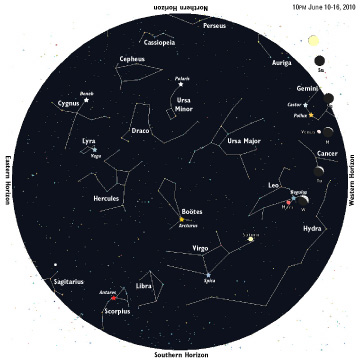Chesapeake Bay's Independent Newspaper ~ Since 1993
1629 Forest Drive, Annapolis, MD 21403 ~ 410-626-9888
Volume xviii, Issue 23 ~ June 10 to June 16, 2010
Home \\ Correspondence \\ from the Editor \\ Submit a Letter \\ Classifieds \\ Contact Us
Best of the Bay \\ Dining Guide \\ Home & Garden Guide \\ Archives \\ Distribution \\ Advertising![]()


Sky Watch

by J. Alex Knoll
Unraveling the Equation of Time
A lot of factors explain this puzzle
Summer solstice is still more than a week away, but the sun rises its earliest of the year just before 5:40 Monday the 14th. While solstice is the longest day of the year, it marks neither the earliest sunrise nor the latest sunset, which falls a week after solstice. This is due to several interacting factors cumulatively called the Equation of Time.
Earth spins on its 231⁄2-degree tilt of rotational axis, which causes the changing seasons. It also affects the time of day that the sun crests the horizon from place to place. As we approach one solstice or the other, the North and South Poles are each bathed in either non-stop light or non-stop darkness for days on end. Clearly our time of sunrise and sunset here in Chesapeake Country in no way correlates to those places.
Additionally, rather than a circle, Earth’s orbit around the sun is elliptical and oblong, like an egg. Summer and winter solstice more or less correspond to the egg’s bottom and top. Right now, as Earth approaches its farthest point from the sun, our orbit is near the more shallow bottom of the egg. Around winter solstice, when earth is about its closest to the sun, it is at the egg’s more sharply curved top. Like a race car on a banked curve, Earth slows down when entering these turns and accelerates coming out of them.
A solar day, the time it takes Earth to make a full 360-degree rotation, is typically 23 hours and 56 minutes. But as Earth approaches either end of the figurative egg, the planet’s rotational speed changes, subtly altering the length of a solar day.
Finally, there’s the difference between a solar day and our 24-hour day. In clock time, any day is divided by 12 noon. Solar noon, however, is when the sun reaches its zenith overhead, which changes day to day. While the longest day is measured from sunrise to sunset, the earliest sunrise is measured as the elapsed time from sunrise to 12 noon, not solar noon.
Illustration: © Copyright 1925 M.C. Escher/Cordon Art-Baarn-Holland; Graphics: © Copyright 2010 Pacific Publishers. Reprinted by permission from the Tidelog graphic almanac. Bound copies of the annual Tidelog for Chesapeake Bay are $14.95 ppd. from Pacific Publishers, Box 480, Bolinas, CA 94924. Phone 415-868-2909. Weather affects tides. This information is believed to be reliable but no guarantee of accuracy is made by Bay Weekly or Pacific Publishers. The actual layout of Tidelog differs from that used in Bay Weekly. Tidelog graphics are repositioned to reflect Bay Weekly’s distribution cycle.Tides are based on National Oceanic and Atmospheric Administration and are positioned to coincide with high and low tides of Tidelog.
© COPYRIGHT 2010 by New Bay Enterprises, Inc. All rights reserved.
